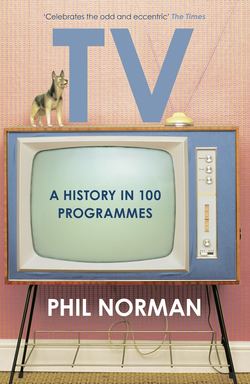Читать книгу A History of Television in 100 Programmes - Steve Berry, Phil Norman - Страница 13
SMALL TIME (1955–66) ITV (Associated-Rediffusion) Giants of children’s television assemble.
ОглавлениеCHILDREN HAVE ENJOYED A special relationship with television since the very first transmissions. The BBC gave them their own playground in the schedules with Watch with Mother, in 1950, where they could enjoy the company of clattering puppet mules, unintelligible folk assembled from garden implements and the very biggest spotty dog you ever did see – all chaperoned by jolly matriarchs dispensing orotund vowels through shatterproof smiles. With its sailor suits and spinning tops and crumpets on the trolley, it was childhood as the Edwardians would have recognised it: the childhood, more or less, of the programme makers, handed down like a careworn teddy bear. When ITV arrived a few years later, its TV crèche was decorated in unmistakeably bolder, more modern style.
Beginning as a fifteen minute segment in Associated-Rediffusion’s weekday Morning Magazine line-up, Small Time soon gravitated towards its natural teatime home, and grew into a proving ground for a vast swathe of children’s TV talent. Many of the segments – Booty Mole, Snoozy the Sea Lion, Gorki the Straw Goat to name a few – would live on only in a few very keen baby-boomer memories. A few, though, added up to as great a legacy as one TV slot could hope to spawn.
The Adventures of Twizzle starred a Pinocchio-esque boy puppet who could extend his limbs at will. The stories, from the pen of Roberta Leigh, were brought to life by puppeteer Joy Laurey, but of more historic note was the show’s producer, future ‘Supermarionation’ chief Gerry Anderson. Another artificial lad, Torchy the Battery Boy, arrived a few years later courtesy of the same team. The results could only be described as ‘sub-marionation’: strings were thick as mooring cables, movements spasmodic. But this was the style, or lack of style, of the times. ‘Production values’ existed neither as jargon, nor as values. The job was done with the means to hand: nothing more and nothing less.
Puppets of the glove variety formed the second line of teatime attack. These were several degrees sprightlier, and occasionally wittier, than their dangling cohorts. Pussycat Willum, a doe-eyed kitten, became Small Time’s eager, if slightly mawkish, figurehead. But the strand’s undoubted star turns were Ollie Beak and Fred Barker. This portly owl and calcified dish mop of a cockney dog were the creations of Peter Firmin, operated by Wally Whyton and Ivan Owen respectively. Their main human foil was Muriel Young, announcer on Rediffusion’s opening night and a primly tolerant foil for the duo’s impromptu shenanigans. More raucous yet were The Three Scampis: Bert Scampi (operator Howard Williams) and his animal pals, hedgehog Spike McPike (Wally Whyton) and aristocratic fox Basil Brush (Ivan Owen). Again, Firmin was the man behind the sewing machine.
Firmin had been introduced to television by Rediffusion’s young stage manager and part-time prop maker, Oliver Postgate. In 1958 Postgate, tiring of organising other people’s programmes, created one of his own. Alexander the Mouse was a whimsical tale of a rodent with royal aspirations, set behind the skirting board of an old house, the first of what would be a long line of wistfully remote Postgate worlds. Firmin painted the characters and sets, which were stuck to metal strips and ‘animated’ live on air by dragging magnets about under the table. This attempt to undercut even the ultra-cheap Crusader Rabbit production technique had the catch that, according to Postgate, ‘hardly a programme went out without … a hand coming into shot or a mouse coming adrift.’30
Postgate’s next attempt, the Willow Patterned Journey of Master Ho, took a more conventional approach to movement. Cut-out figures were manipulated in stop motion in a makeshift studio in Postgate’s North Finchley back bedroom, shot and edited on a 16mm film rig made of Meccano and string for £175 per ten minute episode. In 1959 he reunited with Firmin to create their first classic story. Ivor the Engine was a gloriously melancholy tale of the sole locomotive of the idyllic Merioneth and Llantisilly Rail Traction Company Limited. Firmin’s watercolour evocations of the Welsh mountains were exquisite, but the tone Postgate’s narration took, hitting a plaintive, nostalgic note halfway between John Betjeman and Dylan Thomas, was the greatest innovation. Moving away from the stiff-backed, once-upon-a-time scene-setting of previous children’s programmes, Postgate injected poetry and personality, trusting small children to engage with something more than a bland narrative of mild peril that ended in time for supper.
As the sixties ran on, Small Time’s big talents slowly dispersed to the four corners of television: Anderson and company to forge a puppet dynasty, Postgate and Firmin to carve a homely niche in animation, Brush to Saturday night ubiquity, and Young to produce acres of glam rock television. The strand’s last significant signing was Pippy the Tellyphant, a pantomime elephant operated by husband-and-wife team Jimmy and June Kidd, which cost an unprecedented £300 to construct. Pippy provokes few nostalgic reveries these days, while her cheaper, humbler companions, strapped for cash but bursting with ideas, have taken their place in the TV annals. The hearts and minds of millions were won over with cardboard and felt.
